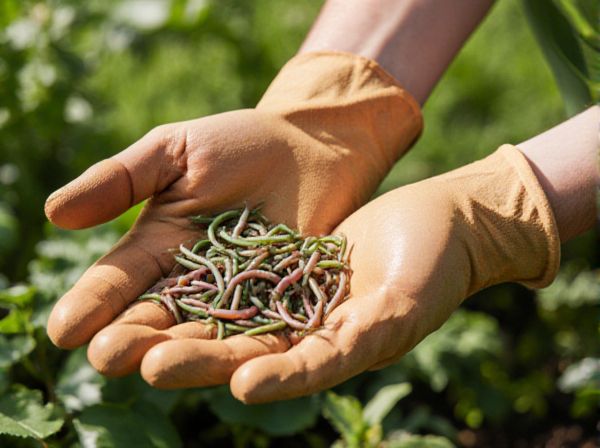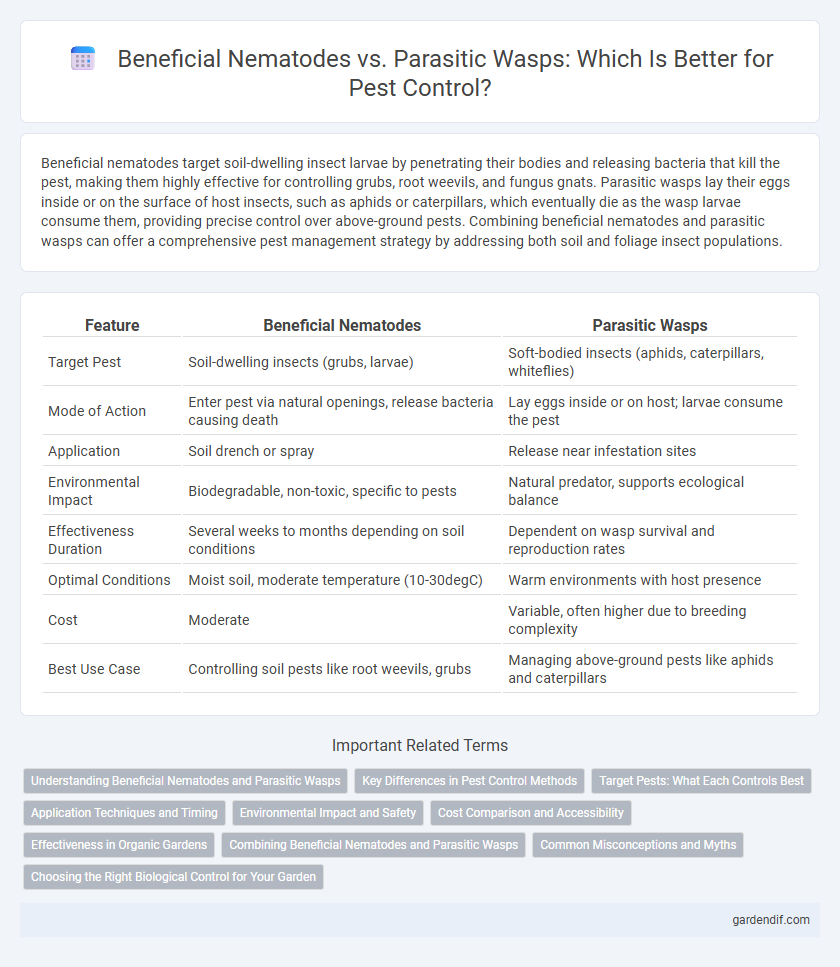
Beneficial nematodes vs parasitic wasps Illustration
Beneficial nematodes target soil-dwelling insect larvae by penetrating their bodies and releasing bacteria that kill the pest, making them highly effective for controlling grubs, root weevils, and fungus gnats. Parasitic wasps lay their eggs inside or on the surface of host insects, such as aphids or caterpillars, which eventually die as the wasp larvae consume them, providing precise control over above-ground pests. Combining beneficial nematodes and parasitic wasps can offer a comprehensive pest management strategy by addressing both soil and foliage insect populations.
Table of Comparison
| Feature | Beneficial Nematodes | Parasitic Wasps |
|---|---|---|
| Target Pest | Soil-dwelling insects (grubs, larvae) | Soft-bodied insects (aphids, caterpillars, whiteflies) |
| Mode of Action | Enter pest via natural openings, release bacteria causing death | Lay eggs inside or on host; larvae consume the pest |
| Application | Soil drench or spray | Release near infestation sites |
| Environmental Impact | Biodegradable, non-toxic, specific to pests | Natural predator, supports ecological balance |
| Effectiveness Duration | Several weeks to months depending on soil conditions | Dependent on wasp survival and reproduction rates |
| Optimal Conditions | Moist soil, moderate temperature (10-30degC) | Warm environments with host presence |
| Cost | Moderate | Variable, often higher due to breeding complexity |
| Best Use Case | Controlling soil pests like root weevils, grubs | Managing above-ground pests like aphids and caterpillars |
Understanding Beneficial Nematodes and Parasitic Wasps
Beneficial nematodes are microscopic roundworms that target soil-dwelling insect larvae, delivering symbiotic bacteria to kill pests effectively while being safe for plants and beneficial insects. Parasitic wasps lay eggs inside or on host insects, with larvae consuming the host from within, providing a natural, species-specific pest control method. Both biological agents offer eco-friendly alternatives to chemical pesticides by exploiting pest life cycles for sustainable garden and crop protection.
Key Differences in Pest Control Methods
Beneficial nematodes target soil-dwelling insect larvae by entering their bodies and releasing symbiotic bacteria that kill the host, making them highly effective for controlling pests like grubs and root weevils. Parasitic wasps, on the other hand, lay their eggs inside or on the surface of pest insects such as aphids or caterpillars, where the developing larvae consume the host from within. While nematodes offer rapid, soil-based pest suppression, parasitic wasps provide ongoing, above-ground control by naturally regulating pest populations through biological parasitism.
Target Pests: What Each Controls Best
Beneficial nematodes excel in controlling soil-dwelling pests such as grubs, root weevils, and fungus gnats by penetrating their larvae and releasing bacteria that kill them. Parasitic wasps are more effective against above-ground pests like aphids, caterpillars, and whiteflies, as they lay eggs inside or on these hosts, leading to their eventual demise. The choice between beneficial nematodes and parasitic wasps depends largely on the pest's habitat and life cycle stage, targeting soil or foliage infestations respectively.
Application Techniques and Timing
Beneficial nematodes require soil irrigation for effective application, targeting larvae in the soil during moist conditions, typically in early morning or late evening to prevent UV damage. Parasitic wasps are released directly onto crops, favoring periods of moderate temperature and low wind to maximize host interaction and parasitism rates. Timing nematode application before pest larvae pupate ensures maximum impact, while wasp releases coincide with early pest appearance for optimal control.
Environmental Impact and Safety
Beneficial nematodes and parasitic wasps both offer environmentally friendly pest control options by targeting specific insect pests without harming non-target organisms or disrupting ecosystems. Beneficial nematodes provide soil-borne pest control by penetrating host larvae and releasing symbiotic bacteria, resulting in minimal chemical residues and low risk to humans, pets, and beneficial insects. Parasitic wasps naturally regulate pest populations by laying eggs in or on host insects, promoting biodiversity and reducing pesticide use, though they require careful species selection to avoid unintended ecological effects.
Cost Comparison and Accessibility
Beneficial nematodes typically cost less per application compared to parasitic wasps, making them a more budget-friendly option for pest control. They are widely accessible through online retailers and garden centers, often sold in concentrated forms that can be stored for extended periods. Parasitic wasps usually require specialized suppliers and can be more expensive due to their live nature and limited shelf life, impacting their availability for both commercial and home use.
Effectiveness in Organic Gardens
Beneficial nematodes effectively target soil-dwelling pests such as grubs, fungus gnats, and root weevils by releasing symbiotic bacteria that kill the host insect larvae, making them highly efficient for pest control in organic gardens. Parasitic wasps excel at controlling above-ground pests like aphids, caterpillars, and whiteflies by laying eggs inside or on the host, leading to natural pest suppression while promoting biodiversity. Combining both beneficial nematodes and parasitic wasps enhances comprehensive pest management across different garden zones, ensuring a healthier and more sustainable organic garden ecosystem.
Combining Beneficial Nematodes and Parasitic Wasps
Combining beneficial nematodes and parasitic wasps offers a robust biological pest control strategy by targeting diverse insect life stages and habitats. Beneficial nematodes effectively eliminate soil-dwelling larvae and grubs, while parasitic wasps specialize in parasitizing above-ground pests such as aphids and caterpillars. Integrating these natural enemies enhances pest suppression, reduces chemical pesticide reliance, and promotes sustainable agricultural practices.
Common Misconceptions and Myths
Beneficial nematodes and parasitic wasps are often confused due to their roles in biological pest control, but nematodes target soil-dwelling insect larvae while parasitic wasps primarily attack above-ground pests. A common misconception is that parasitic wasps are harmful to humans, whereas they are species-specific and pose no threat to people. Another myth is that beneficial nematodes can survive in any soil condition, but their effectiveness decreases in dry or highly alkaline soils.
Choosing the Right Biological Control for Your Garden
Beneficial nematodes target soil-dwelling pests like grubs and root weevils by penetrating and killing larvae, making them ideal for underground pest control. Parasitic wasps excel at managing above-ground pests such as aphids and caterpillars by laying eggs inside or on the host insect, resulting in natural pest population reduction. Selecting the right biological control depends on the specific pest species, infestation location, and desired ecological balance within your garden ecosystem.
Beneficial nematodes vs parasitic wasps Infographic

 gardendif.com
gardendif.com